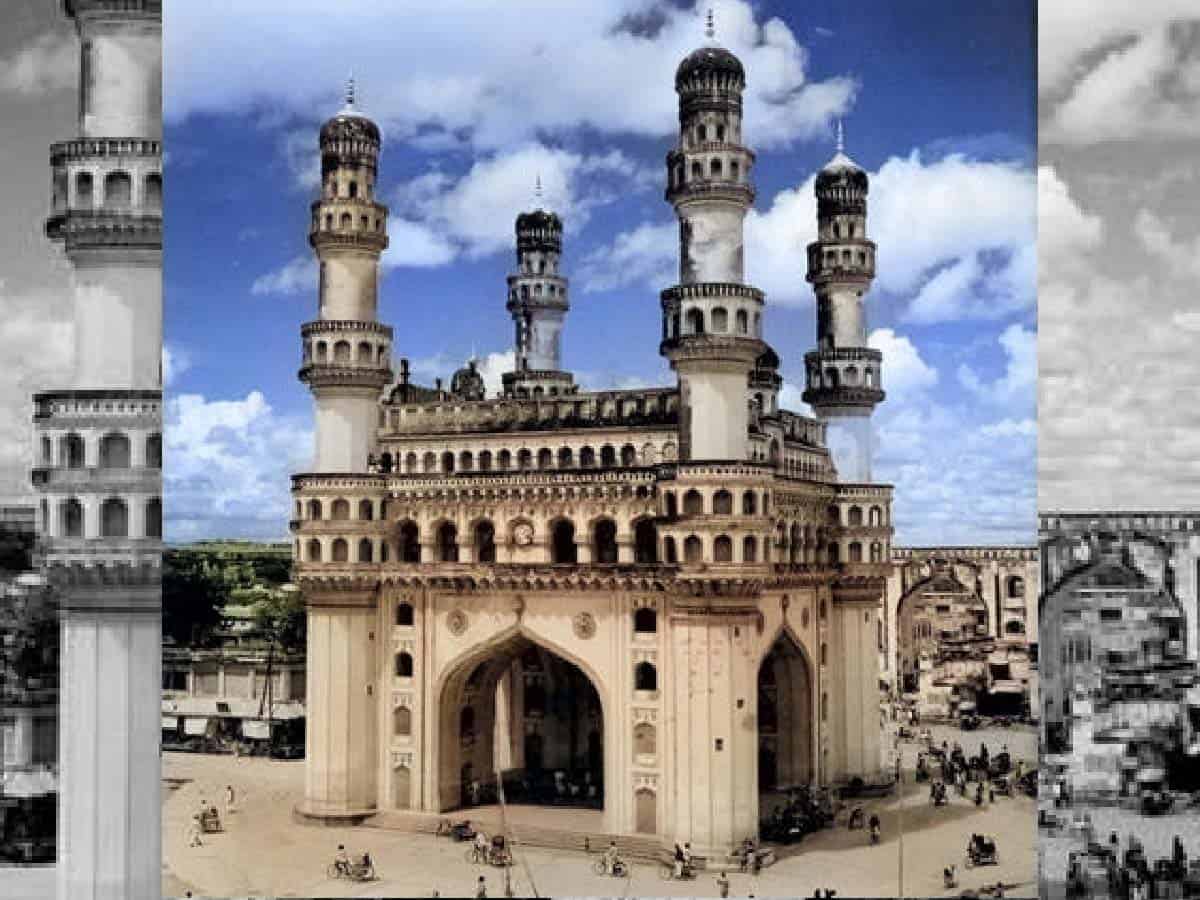
The Charminar is always newsworthy. The more we get to know the monument, the more elusive it becomes. Over the years, a lot has been written about the naming of the city of Hyderabad, but not much has been written about its foundation date as whatever is available in the form of contemporary records has been more or less accepted by historians. Assigning a date to the Charminar is assigning a date to Hyderabad as the Charminar was the first monument built in the city of Hyderabad. This hasn’t been easy for historians of yore as nowhere on the monument is this fact inscribed nor is the year of construction directly given in any record either.
Among the Indo-Persian histories that throw light on the history of the Qutb Shahis of Golconda-Haidarabad, the Tarikh-i-Muhammad Qutb Shah, the official chronicle of the Qutb Shahi dynasty, gives the date of 1000 A.H./1592 A.D. for the laying of the foundation of Hyderabad when in the same year the famous edifice of the Charminar was supposed to have been constructed. The manuscript is an anonymous work of the first part of the Qutb Shahi rule that gives a comprehensive account of many aspects including the details of the layout of Hyderabad. It was compiled under the order of Sultan Muhammad Qutb Shah in 1616 and is housed in the Salar Jung Museum library.
Now coming to the Indo-Persian histories written in the Deccan in verse, the Tawarikh-i-Qutb Shahi dedicated to Muhammad Quli Qutb Shah by an anonymous author is preserved in the India Office Library and deals with the reigns from Sultan Quli to Muhammad Quli Qutb Shah. Haroon Khan Sherwani, the eminent expert on the Deccan quotes from here in his magnum opus book History of the Qutb Shahi Dynasty.
Then there is the Tuzuk-i-Qutb Shahi quoted by Syed Ali Asghar Bilgrami in Landmarks of the Deccan which says “owing to the outbreak of cholera the inhabitants fixed a huge tazia in the heart of the city on Thursday 1st Muharram 999 A.H. as a charm to ward off the epidemic and when it subsided the huge building of Charminar was constructed at the same site.” Sherwani does not agree that the Charminar was built according to the pattern of a tazia. He says it was common to have a central square with a big building in many cities.
Syed Athar Abbas Rizvi in his book Socio-intellectual History of the Isna Ashari Shiis in India is of the opinion that Mir Momin Astrabadi, the peshwa who was entrusted the task of planning the new city of Hyderabad had the holy city of Mashhad in mind where Imam Raza’s tomb is placed at the centre which took the shape of Charminar in Hyderabad. Mir Momin Astrabadi was an eminent Moosvi Syed of Astrabad, Gilan, Iran and an Alim who drew the first outline map of Hyderabad city. Dr Saiyyada Jafar says after Muhammad Quli acceded to the throne, in 1581 he added the symbol of the alam on his coins which reflect his deep faith in Imam Hussain. Sherwani also echoes the same thought about Muhammad Quli’s psyche that before the Jama Masjid, Muhammad Quli got the Badshahi ashurkhana constructed in Hyderabad and installed the alams of the fourteen innocents (masumin). His seven poems, manqibats, in honour of Hazrat Ali and a dozen more poems on Idd-e-Maulud-e-Ali and Idd-e-Ghadeer reflect his ardent attachment to Shiism. Muhammad Quli Qutb Shah and his Shia Iranian Afaqui’s devotion to naming Hyderabad after Hyder, a name given to Hazrat Ali, with Charminar as the first monument to be built also reflected the patronage sought from Shah Abbas Safavi of Iran who was in a position to exert pressure on Mughal expansionist plans on Golconda.
Sadiq Naqvi in his book, The Iranian Afaquis Contribution to the Qutb Shahi and Adil Shahi Kingdoms, quotes from the Maktubat Salatin-i-Safawia that has Mir Momin’s secret letter to Shah Abbas Safavi expressing his intention to popularise the idea of Ahl-e-Bayt and Shia doctrine in the new city. Therefore the sultan and his peshwa adopted the first month of Muharram of the Hijri calendar as the holy month to lay the foundation of the city of Hyderabad when Prophet Muhammad’s grandson Imam Hussain was martyred on the tenth day along with 72 relatives on the battlefield of Karbala in 61 A.H.
Sadiq Naqvi considers Muhammad Quli Qutb Shah as the architect sultan of Golconda. His comparatively peaceful reign and creative bent of mind went into the building of a new city. Sherwani says the plan to construct the city was ready in 999 A.H./1591A.D. at the site of the plain area south of river Musi. Then Muhammad Quli Qutb Shah collected master craftsmen, architects, masons, stone cutters, and designers to build a city that was to be a replica of paradise. Mir Momin Astrabadi was deputed this task and he designed Hyderabad’s piazza of the Charminar and Charkamans as a replica of the Maidan-i-naqsh jahan of Safavid Isfahan. That was the reason Hyderabad was known as Isfahan nau.
Hyderabad’s foundation date chosen in the month of Muharram is central to Shia ideology professed by Muhammad Quli and his nobles. While the Charminar, which marks the beginning of this new city, still remains an enigma how such a colossal monument with beautiful embellishments in stucco could have been built in just a little over a year defying all levels of common sense. It also remains to be reviewed whether it was the epidemic of plague or cholera that afflicted the people at this time which also is given as a reason for the construction of the Charminar. The search for more details will continue.
Prof Salma Ahmed Farooqui, a regular contributor to Siasat.com, is the director of H K Sherwani Centre for Deccan Studies, Maulana Azad National Urdu University, Hyderabad. She is the author of A Comprehensive History of Medieval India and several other books.

